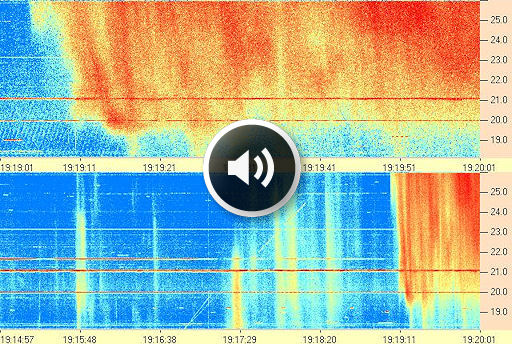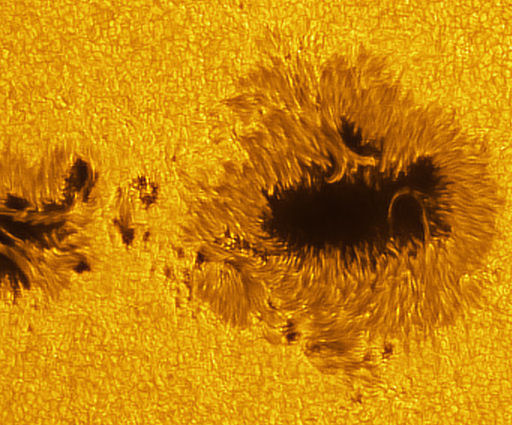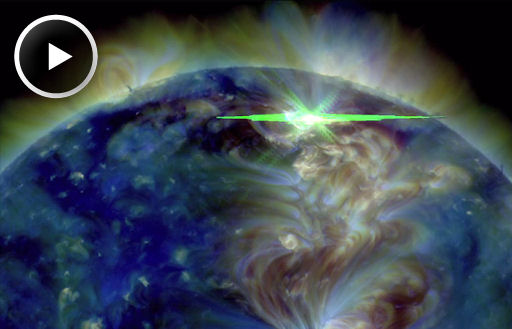24 сентября на Солнце зарегистрирована вторая вспышка высшего балла "X" за 3 дня
26-09-2011, 08:21. Разместил: VP
24 сентября на Солнце зарегистрирована вторая за 3 дня вспышка высшего класса X по пятибалльной вспышечной шкале.
Как и первое событие от 22 сентября 2011 года, вспышка произошла в области с номером 1302 по каталогу американской службы NOAA. Тем самым данная область, похоже, побила прежний рекорд активности, и стала самой крупной по энерговыделению в этом солнечном цикле.
Два больших взрыва в одной области Солнца не являются уникальной ситуацией. Вместе с тем, любой области после вспышки требуется некоторое время, чтобы накопить энергию, достаточную для следующего крупного взрыва.
То, что в данном случае, между двумя событиями высшего балла прошло всего двое суток, говорит, что характер солнечной активности, в целом, все больше напоминает солнечный максимум. Не исключено, что это может передвинуть текущий прогноз на год солнечного максимума с 2013 года, куда он был переведен в прошлом году, обратно на вторую половину 2012 года.
Как и предыдущая вспышка от 22 сентября данное событие сопровождалось крупным выбросом массы, который, однако, произошел уже не под углом около 80 градусов к линии Солнце-Земля, как прежнее событие, так и не задевшее Землю, а на более близком расстоянии — около 50 градусов.
Причина в том, что из-за вращения Солнца область 1302 с каждым днем перемещается все ближе к линии Солнце-Земля.
В результате, вспышки, происходящие здесь, с каждым днем становятся все более геоэффективными.
Непосредственно на линии Солнце-Земля область окажется 28-29 сентября. Если до этого времени ее уровень активности не снизится, "уклониться" от выбросов солнечной плазмы у нашей планеты уже не получится.
Общий уровень активности Солнца, измеряемый по пятнообразовательной деятельности и по потоку рентгеновского излучения, в настоящее время составляет около 50% от максимума предыдущего цикла. Чтобы достичь и превысить в 2012-2013 годах максимум прежнего цикла нашей звезде, таким образом, надо увеличить свою активность еще примерно в два раза.
Лаборатория рентгеновской астрономии Солнца (ФИАН)
STRONG SOLAR ACTIVITY: Having already unleashed two X-flares since Sept. 22nd, sunspot AR1302 appears ready for more. The active region has a complex "beta-gamma-delta" magnetic field that harbors energy for strong M- and X-class eruptions. Flares from AR1302 will become increasingly geoeffective as the sunspot turns toward Earth in the days ahead.
On Sunday, Sept. 25th, Dutch astrophotographer Emil Kraaikamp took a magnificent picture of the active region, which is so big only half of it fits on the screen. Click to view the entire sunspot:
"This is how the sunspot looked through my solar-filtered 10-inch Newtonian telescope," says Kraaikamp. "Due to the always-variable daytime seeing here in the Netherlands, it took a couple of hours to finally capture one good set of images, but it was well worth the effort to get this view of the huge sunspot formation."
STRONG SOLAR ACTIVITY: On Saturday morning, Sept. 24th, behemoth sunspot 1302 unleashed another strong flare--an X1.9-category blast at 0940 UT. NASA's Solar Dynamics Observatory recorded the extreme ultraviolet flash:
The movie also shows a shadowy shock wave racing away from the blast site. This is a sign that the blast produced a coronal mass ejection (CME). Analysts at the Goddard Space Weather Lab say the CME could deliver a glancing blow to Earth's magnetic field on Sept. 26 at 14:10 UT (+/- 7 hours); click here for an animated forecast track. Geomagnetic storms are possible when the CME arrives. Aurora alerts: text, voice.
SOLAR STATIC: Active sunspot 1302 has turned the sun into a shortwave radio transmitter. Shock waves rippling from the sunspot's exploding magnetic canopy excite plasma oscillations in the sun's atmosphere. The result is bursts of static that may be heard in the loudspeakers of shortwave radios on Earth. Amateur radio astronomer Thomas Ashcraft recorded this sample from his backyard observatory in New Mexico on Sept. 24th:

Dynamic spectrum: The horizontal axis is time (h:m:s), the vertical axis is frequency (MHz). Image credit: Wes Greenman
"Saturday was a super-strong solar day with near continuous flaring and radio sweeps," says Ashcraft. "The sound file (above) corresponds to an M3 flare at 1918 UTC. It was the strongest radio sweep of the observing day."
"Try listening to the radio bursts in stereo," he advises. "I was recording on two separate radios at 21.1 MHz and 21.9 MHz, and I put each one into its own channel of the audio file. This gives a spatial dimension as the bursts sweep down in frequency."
Вернуться назад


